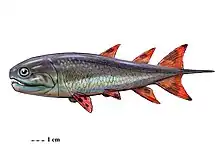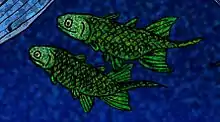| Strunius Temporal range: Late Devonian | |
|---|---|
 | |
| Restoration of S. rolandi | |
| Scientific classification | |
| Domain: | Eukaryota |
| Kingdom: | Animalia |
| Phylum: | Chordata |
| Clade: | Sarcopterygii |
| Order: | †Onychodontiformes |
| Family: | †Onychodontidae (?) |
| Genus: | †Strunius Jessen, 1966 |
| Type species | |
| †Strunius rolandi Jessen, 1966 | |
Strunius is an extinct genus of lobe-finned fish from the Late Devonian period of Germany.

Although it was a lobe-finned fish, Strunius' fins were supported by fin rays, which are more associated with ray-finned fish. However, its skull was composed of two articulating halves, a feature characteristic of the lobe-finned rhipidistians. The skull was also divided by a deep articulation, with both halves probably connected by a large muscle, increasing the power of the bite.[1] The same system is seen in coelacanths and the better-known Eusthenopteron.
Compared to other lobe-finned fishes, Strunius had a rather short, stubby body, and was just 10 centimetres (4 in) long. It was covered in large, round, bony scales, and probably fed on other fishes.[1]
References
.jpg.webp)
.jpg.webp)
_(cropped).jpg.webp)
.jpg.webp)
